Intracytoplasmic Sperm Injection - ICSI
Video Advances in IVF, In Vitro Fertilization
ICSI (Intracytoplasmic sperm injection) is a method used to fertilize eggs in the IVF lab and it is very effective. It involves injecting a single sperm into an egg in order to be fertilized. Therefore, it is considered a major development because in this procedure, fertilization is possible even with a very small number of sperm.
It involves the use of specialized tools and inverted microscopes to enable the embryologist to pick up a sperm using a specialized ICSI needle that is carefully advanced through the egg membrane then the sperm is injected into the inner part of the egg (the cytoplasm), then fertilization occurs in 75 - 85% of eggs injected with sperm.
Indications of Intracytoplasmic Sperm Injection ( ICSI )::-
- Male infertility factors that includes low sperm counts, poor motility or movement of the sperm, poor sperm quality, sperm that lack the ability to penetrate an egg or azoospermia.
- Failure of fertilization in previous IVF attempts.
- If the male partner underwent a vasectomy and sperm have been collected from the testicles or epididymis.
- If male partner has problems in erection or ejaculation.
- It is used for couples with a small number of eggs at egg retrieval, to get a higher percentage of eggs fertilized than when mixing eggs and sperms together in the IVF procedure.
- Note: ICSI is recommended by some clinics only for severe male factor infertility. On the other hand, some clinics use it for every case.
IVF And ICSI Videos
The Procedure of Intra-cytoplasmic sperm injection (ICSI)
- The ovaries of the female partner will be stimulated to produce more eggs
- The eggs are then collected by using a fine, hollow needle with ultrasound guidance.
- A single sperm pick up is done by using a very delicate needle. This needle will be inserted carefully through the shell of the egg into the cytoplasm of the egg and the sperm will be injected. Then the needle is removed. This does not guarantee the fertilization, but it gives an opportunity for that process to commence and to produce embryos.
- The embryos then will be transferred to the uterus 2 to 3 days after fertilization or 5 days after fertilization when the embryo reaches the blastocyst stage.
- Pregnancy test should be done 2 weeks after the embryo transfer.
Intra-cytoplasmic sperm injection (ICSI) Photos
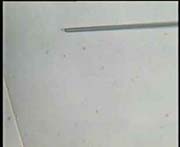
Presperm loading
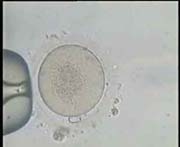
Holding the Egg
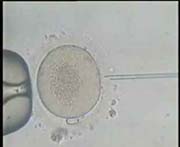
Step 1
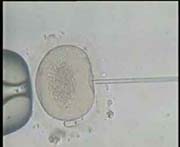
Step 2
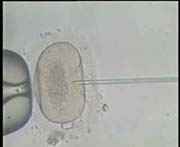
Step 3
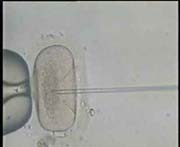
Step 4
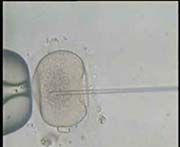
Step 5
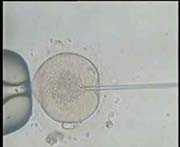
Step 6
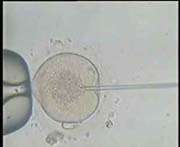
Step 7

Methods of sperm retrieval which are used for ICSI:
- If there were sperm in the semen, a sperm sample can be produced by normal ejaculation into a cup on the same day of egg collection.
- If there is no sperm in the semen, the doctor can extract sperm from the male partner under local or general anesthesia by:
Percutaneous Epididymal Sperm Aspiration or Extraction and ICSI (PESA , MESA)
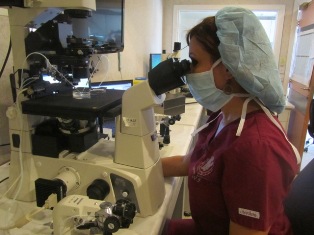
It is only required if the husband has one of the following problems:
- Absence of the vas deferens (through which the sperm passes from the epididymis to the seminal fluid ) .
- Past Infections that result in obstruction.
- Cases who have had a vasectomy and surgical reversal failed.
Testicular Sperm Aspiration or Extraction and ICSI (TESA, TESE)

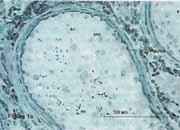
This is done by obtaining sperm directly from the testes, either by aspiration, using a needle or surgical extraction (Taking a very small piece from the testes ).
The sperm are then used to do the ICSI procedure as described above.
This method is used in the following cases:
- Absence of sperms in the epididymis.
- Absent or obstructed epididymis.
- TESE might be done before the beginning of the treatment cycle and the collected sperm are then frozen.
See our Success rates
Disadvantages of Intra-cytoplasmic sperm injection (ICSI)
- The same risk of multiple births and ectopic pregnancy associated with standard IVF is applied to ICSI.
Dr Najeeb Layyous F.R.C.O.G
Consultant Obstetrician, Gynecologist and Infertility Specialist







 Pregnancy Due Date Calculator
Pregnancy Due Date Calculator
 Chinese Gender Predictor
Chinese Gender Predictor
 Ovulation Calculator
Ovulation Calculator
 IVF Due Date Calculator
IVF Due Date Calculator
